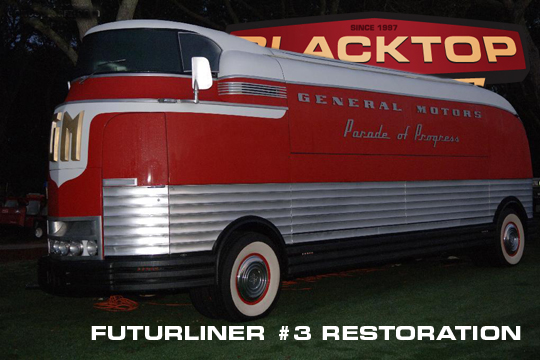This story is the beginning of a new series sent to us by Sherri Candland from Kindig-It Designs in Salt Lake City. Kindig-It has been awarded the restoration of GM’s Futurliner #3 and we will follow the progress with Sherri’s articles. [Ed.]
First a bit of history…

Story and photos provided by: Sherri Candland
In 1933, “A Century of Progress” World’s Fair opened on 427 acres at Chicago’s Navy Pier. The focus was on scientific and technological progress of the current times. Chicago hosted that fair for over 2 years and accommodated over 48 million visitors. A number of automobile manufactures introduced concept cars during the two year run of the fair. Cadillac wowed crowds with their Fastback Fleetwood V-16, which was touted as a styling triumph of it’s time. Not to be outdone by Cadillac, Lincoln presented a rear engine precursor to what would become the production front engine Zephyr. But the judges’ favorite was Packard, with their Dietrich modified Packard 12, which received top honors and was named “Car of the Dome”.
General Motors, with an intense focus on technology and more importantly, education, set up a futuristic Pavilion at the World’s Fair called “Century of Progress”. Among other wonders, it housed a full fledged assembly line producing new Chevrolets right before the very eyes of an amazed audience. The other half of the building focused on technological displays for every man’s curiosity. These included, a Fountain of Color, demonstrating ultra violet lights striking mineral rocks and producing a full range of the rainbow. The Magnetic Stove, where water boils in a teakettle on a book. This was done by a 1600 cycle induction coil causing the molecules of metal to vibrate creating intense heat. These don’t seem like earth shattering displays to today’s technological standards, but for the time they were cutting edge. And, these did not go unnoticed by Charles “Boss Ket” Kettering, now Vice President of the GMI, General Motor Institute for education.
Charles Kettering, wanted to take GM’s show on the road so people all across North America could experience the exciting new advancements. And there was the birth of the “Parade of Progress”. Kettering returned to Detroit and presented his idea of a traveling road show to GM’s corporate board members and won instant approval.
This “Parade of Progress” took to the road in 1936, with 8 Streamliners, specially built vans to house displays, along with 9 semi truck-trailers housing tents and support items for the show. Leading the impressive caravan into town was always a GM concept car, and in 1936 it was the World’s Fair Cadillac V-16 Fastback. The parade would typically play to audiences for up to five days at each destination and then it was off to the next town.
After touring over a million miles and displaying to over twelve million people in the U.S., GM executives decided it was time for a change-one that would make the “Parade of Progress” bigger and better. In 1939, GM introduced 12 Futurliners, hand built buses that could house each technological display in its main body. The estimated cost of each Futurliner in 1939 was said to be $100,000 each. They had a pilot type driver’s compartment with center mounted steering wheel, rubber bumpers, spectacular in appearance, and were easy to clean and operate. Now the caravan was even more impressive, including concept cars, 8 Streamliners, 9 Semi’s and now 12 Futurliners. It must have been quite a site to see heading to small cities across America, better than even the circus coming to town. But that image would have to wait; World War II halted all of GM’s plans, but only temporarily.
After the war ended, the United States Manufacturing industries were trying to make the switch from wartime production back to peacetime manufacturing, and it was difficult labor strikes and union disputes occurring often. And between 1950 and 1952, GM experienced a 30% drop in domestic car and truck sales. But in 1953, the Futurliners were back on the road, with some improvements, most importantly a larger engine, and air conditioning.
The “Parade of Progress” was back on the road, bigger and better than before World War II. But this post war success would be very short lived. On July 4th, 1956 in Spokane, Washington the “Parade of Progress” and the Futurliners made their last showing. Over 70,000 people were in attendance for the finale.
What contributed to the demise of the “Parade of Progress”? Believe it or not, network television. GM could now reach massive audiences at a fraction of the cost of the road show and with less inconvenience.
There are only 10 Futurliners in existence today. Number Eleven sold at the Barrett-Jackson auction in 2006, for $4,000,000.00, while Number 10 is restored and in the National Automotive and Truck Museum of the U.S. in Grand Rapids, Michigan. And now Number Three will be at Kindig-It Designs to undergo a year and a half restoration. This is a very exciting piece of history to come to Utah. It will be a pleasure to report back each month on its progress and offer more historical tidbits as well.
For more information on the GM Futurliner visit www.futurliner.com. For more information on Kindig-It Designs visit www.kindigit.com.




